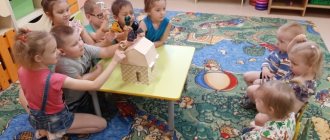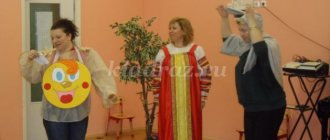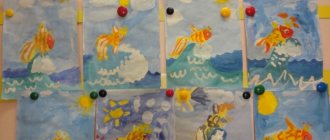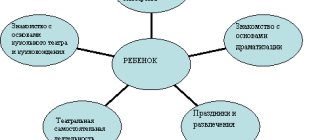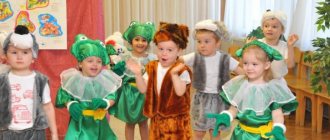Preparatory group. Senior preschool age. Children 6-7 years old
Synopsis of an interactive theatrical performance for children of the preparatory group "Real Friends" Interactive - theatrical performance "Real Friends"
.
(for children of the preparatory group)
Explanatory note Preparatory group.
Venue: music hall of MBDOU “Kindergarten No. 1 “Alyonushka”
Duration: 30 minutes. Decorations and equipment: Winter forest;…
Theatricalization of the fairy tale “Ku-ka-re-ku” in the preparatory group Goal. Development of children's creative abilities through theatrical art . Tasks. Develop interest in theatrical and play activities . Create favorable conditions for children to develop a sense of partnership, learn ways to interact positively with adults and...
Project on theatrical activities “We play theater” (preparatory group)
Project on theatrical activities “We play theater” (preparatory group)
Author: Odinokova Anastasia Konstantinovna Teacher of the first qualification category
Municipal autonomous
preschool educational
institution No. 16 "Ryabinka" in the city of Dubna, Moscow region
Abstract to the project:
This project “We play theater” is intended for children of senior preschool age
6-7 years.
The project selected different types of theatres: cone theatre, puppet theatre, tabletop theatre, dress-up and mask theatre, flannelgraph theatre. The project uses technology, bright modern visuals, comprehensive thematic planning, various types of theaters for children of senior preschool age
. This project will help children make an exciting journey into the magical world of theater. Overcome timidity, self-doubt, shyness. Thus, theater helps the child develop comprehensively.
Passport Project participants: -Children of the preparatory group, teacher, parents of pupils Age of children: -age of children 6-7 years Type of project: -practice-oriented, group Duration: -long-term Result: -presentation of the project at the pedagogical council.
Relevance of the project:
“It’s not for nothing that children love fairy tales. After all, the good thing about a fairy tale is that the soul already anticipates a happy ending in it. And brave hearts agree to any trials, in impatient anticipation of a prosperous end...” (Valentin Berestov)
Nowadays, children do not suffer from a lack of information. And the main carriers for preschoolers are kindergarten and family. In kindergarten, the child is in a constant state of discovery in a variety of areas: fine arts, music and much more. Little pioneers in constant search of the unknown. They are driven by interest and endless curiosity. Our task is to direct the child’s interest in the right direction, to open before him the opportunity to develop spiritually and mentally.
Children's theater, thanks to its enormous emotional impact on the child's soul, is able to take on developmental tasks: feelings - emotions, memory, imagination, intelligence and resourcefulness, broadening one's horizons, kindness and pity, courage. Theater is always a holiday for a child, a bright, unforgettable experience. The expression “The fairy-tale world of childhood” is not empty words. In the life of a child from his very birth there is a fairy tale with its good heroes. Will an adult believe that a chicken can lay a golden egg, or dream of a magic wand that will solve all problems? Of course not. And the child is convinced that if he waves a magic wand, a miracle will happen. Children believe in miracles and that somewhere on earth there is an extraordinary fairy-tale country in which birds and animals can talk to each other and live in friendship. And this country exists, and it is called Theater!!! The fairy-tale world of theater is a land of real fantasies and good fairy tales, a game of fiction and reality, colors and light, words, music and mysterious sounds. Theater is a fertile ground for creativity; everyone who wants to take part in this action will find something to their liking.
It’s impossible to play in the theater without emotions. That is why the same poem will be recited by a child expressively and artistically at one time, and sluggishly and monotonously at another. “Emotions energize and organize perception, thinking and actions.” When learning a role, the child tries to convey the mood of the hero of the fairy tale with facial expressions, expressive speech and movements. This is where the child gets acquainted with various emotions: Interest, surprise, fear, grief, anger, shame. Theatrical creativity has an emotional development effect on children when he plays a role, interacting with peers, or sitting in the auditorium. Every time, leaving the theater, any child takes away with him, albeit a small, but discovery. The words spoken by K.S. Stanislavsky about creativity in the theater can also be attributed to children’s theater, since they contain the essence of the foundation and success of any theater: “Creative work on the role and on transforming the playwright’s verbal work into a stage story, everything from beginning to end, proceeds with the participation of the imagination.” Theater is for a child an inexhaustible source of development of real feelings and fantasies.
The child constantly plays, learning about the world and himself through play. In the theater, a child unwittingly finds himself in situations, the way out of which requires some intelligence. Such moments arise infrequently and only if adults and children take part on equal terms in the game called theater. In children's theater, against the backdrop of active emotional development, two more directions in education exist and harmoniously complement each other: the development of intelligence in a child and the instilling in him of social and moral qualities. A variety of children come to the theater. The behavior of some of them can be characterized as constrained, shy, timid, and indecisive. Some children remain like this for a short time, their stiffness is associated with the new environment in which they find themselves: new faces, unfamiliar objects. Performing in front of an audience, and especially in front of friends, will not be a psychological barrier for them. The relationship that exists in children's theatrical activities forces children to more often contact each other with requests and questions. Children become more sociable, they make new friends, which in turn makes them relaxed.
Theater for a child becomes an amazing, special world. Where any wish will certainly come true, and no matter what happens, everything will certainly end well.
Expected result: - Awakening children's interest in theatrical activities - Children must master some types of theatrical activities (cone theater, puppet theater, table theater, dress-up and mask theater, flannelgraph theater) in accordance with their age - Develop the ability to convey the character of the character and intonation expressiveness of speech, facial expressions, gestures - Master the skills of theater design Involving parents in the production of different types of theater, creating costumes - Convey all theatrical activities to parents through questionnaires, consultations and conversations.
Project goal: -To introduce children to theatrical art and theatrical activities
Objectives: - Create conditions for organizing joint theatrical activities - Expand children's understanding of the theater, its types, attributes, costumes, scenery - Form an artistic and aesthetic developmental subject environment in the group - Create conditions for joint theatrical activities of children and adults, aimed at bringing children closer together , parents and teachers (staging joint performances with the participation of children, parents, employees, organizing performances by children of older groups in front of younger ones). -Develop emotionality and expressiveness of speech in children - Promote the self-realization of each child and create a favorable microclimate, respect for the personality of the little person - Ensure interconnection with other types of activities: music, fiction, design, drawing.
Work with parents: -Questioning -Issue of consultations “Playing theater with children at home” -Conversations with parents -Assistance in making theater props
Forms of work:
1. Joint activities with children: - theatrical games - outdoor games
- speech games - fairy tales - retellings - rhythmoplasty - the use of various types of theaters - viewings of theatrical works - plot - role-playing games - visiting theaters - theater showings 2. Independent activity of children in the theater corner 3. Integration with other educational areas: - artistic creativity - design -reading fiction - music -
speech development
4. Interaction with the family - joint theatrical and leisure activities - preparation of recommendations for parents on organizing theatrical activities - visiting parents and children to theaters and performances 5. Interaction with the deputy. head of educational and methodological work - consultation with the music director All work allows you to increase theatrical activity.
Thematic plan:
September. Conversation with children: “Getting to know the theater” Hood. — aesthetic development (Drawing) “Curtain and stage for the theater” Lesson summary “What is theater” Reading fiction: Russian folk tales
October. Conversation with children: “How to come up with your own theater, what is needed for this” Psycho-gymnastics “Imagine yourself differently” Visit to the exhibition of Hood dolls. — aesthetic development (Drawing) “Zayushkina’s hut” November. Introduce children to several types of theaters “Cone Theatre” Fairy tale dramatization: “Teremok” Finger gymnastics: “Turkey” A selection of board games about animals December. Conversation with children: “My favorite fairy tales”, “Favorite fairy-tale characters” Hood. - aesthetic development (Drawing) “Create your own theater” A selection of fairy tales and characters from the finger theater “The Fox and the Crane”, “The Ryaba Hen”, “Turnip”, “Kolobok”
Staging a fairy tale: “Turnip” Reading fiction: “Fairy tales - retellings” January. Visit to the puppet theater: “Friendship of Friends” Conversation with children: “Names of theaters, heroes of these theaters” Viewings of theatrical works Plot-role-playing games February. Reading fiction: “Masha and the Bear” Joint activities with parents Organizing a visit to the Hood library. — aesthetic development (Modeling) “The fairy-tale hero of any fairy tale” Introduction to the puppet theater March. Participation of children in the production of the play “In Search of Cinderella” Plot - role-playing games in the theater corner of Hood. — aesthetic development (Applique) “Teremok” D/i “Collect a fairy tale” April. Visit to the puppet theater “Merry Friends” Reading fiction: “The Ant and the Dragonfly” Show of the puppet theater for kids “Kolobok” May. Work with parents: Questioning “Theater and Children” Demonstration of tabletop theater: “Thumbelina” Design of a stand for parents D/i “Guess the fairy tale from the description”
Types of theaters:
Table theater The name of this type of theater speaks for itself - play activities are carried out on the table. Its peculiarity is that the scenery and characters must be small in size so that it is possible to place all the necessary attributes of the game on the surface
Theater on a flannelgraph (a board covered with fabric) To organize this type of activity, you will need a flannelgraph made yourself and character figures of the chosen work of art, on which you need to attach Velcro or velvet paper to the back side. Thus, as the plot develops, the child is invited to attach the necessary figures to the flannelgraph.
Dress up and mask theater This is a theater where children take on the role of a chosen character. Children, with the help of an adult or independently, act out short fairy tales. For better visibility, children need costumes. You can buy them in a store or sew them yourself. In kindergarten, in each group or at home, it is advisable to have a costume room, where costumes are sewn by the hands of parents and children. Masks - caps - are made according to the size of the performer's head. These can be knitted hats or characters drawn on cardboard, which are attached with an elastic band around the head.
Puppet theater This type of theatrical art is very popular with children, as it allows each child to open up individually in the process of learning to work with a puppet and in the rehearsal process, to overcome their complexes of embarrassment and uncertainty, to learn to play with the help of a doll, to enliven it with their actions and manner of movement and speak.
Cone theater Helps to learn to coordinate hand and eye movements and accompany finger movements with speech. Express your emotions through facial expressions and speech.
Project conclusions:
The children became interested in theatrical activities. The children got acquainted with different types of theaters. Thanks to joint activities during the implementation of the project, the relationship between children and adults was strengthened. Children have become more sociable with each other, liberated, confident in themselves and their abilities, and are not afraid to speak in front of the public. In my parents, I found support not only for the preparatory work (making scenery, costumes, toys), but also saw in them talented teachers of their children. I showed parents that only through joint activities can they get to know their child better, his temperament, and friendly relations between children and adults. Created an atmosphere of creativity. My project allowed children, parents and teachers to show their creative activity and fully reveal the emotional capabilities of children. Thus, we can conclude that the “We Play Theater” project has created favorable conditions for the development of children’s abilities in theatrical activities.
List of used literature:
Artemova L. V. “Theatrical games for preschoolers.” Antipina A. E. “Theatrical activities in kindergarten.” Baryaeva L. I., Vechkanova I. I., Zagrebaeva E. A., Zarin A. A. “Theatrical games-activities with children” Ivanova G.P. "Theater of Moods" Makhaneva M. Theatrical activities of preschool children Migunova E.V. Organization of theatrical activities in kindergarten
: Educational and methodological manual. Petrova T.I., Sergeeva E.L., Petrova E.S. Theatrical games in kindergarten. Internet resources
